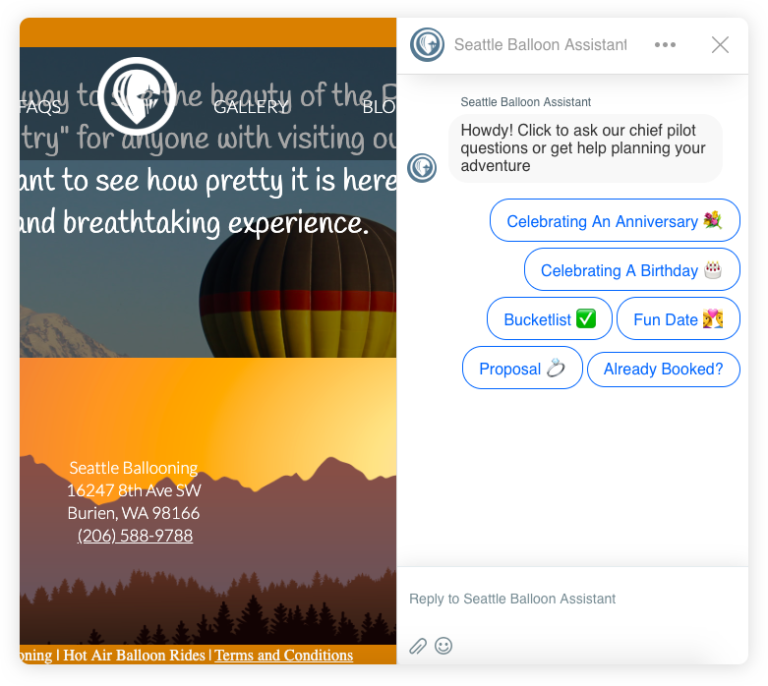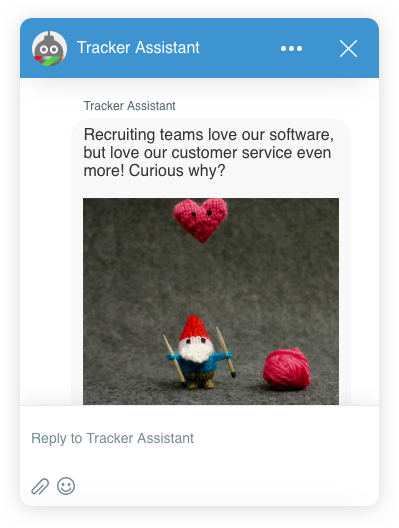By: Eliav Cohen and Lindsay Angelo
The secret to getting 15, 20, 30, or even 40% bot engagement is all about personalization and context. While this may sound simple, many companies still miss the boat on the basics, losing out on huge opportunities to streamline lead qualification, improve customer experience, and ultimately increase conversion rates. Used correctly, conversational marketing replicates the in-person “human” sales experience that is so effective offline; but to achieve this, you need well-designed and structured bots—something we happen to know a few things about at Ultra Cool.
From Door-to-door Sales and Hot Air Balloons to Bots
Long before I founded Ultra Cool, a Drift conversational marketing partner specializing in building contextual hyper-personalized chatbots, I was introduced to the world of sales selling educational books door to door—80 hour weeks and conversations with a total of 40,000 prospects face to face. Who would have guessed the lessons learned in this “other life” would be so valuable to the work I do with chatbots today?
When I first began pounding the pavement, I made the rookie mistake of leading with my sales pitch, which earned me the painful experience of having a lot of doors closed in my face. Things changed dramatically for the better when I learned the secret sauce—adding context and personalization to my sales approach. Instead of jumping to, “I’m selling educational books. Want to take a look?” (which only got me through the door about 10% of the time), I’d contextualize the conversation. This meant including relevant details about the local school, teachers, and even other families I’d spoken to. This approach not only made the conversation more interesting to the prospect, it also upped my credibility by association. The result: 20 to 25 people out of every 30 consistently agreed to sit down with me.
Flash forward 15 years and those valuable sales lessons carried over to my next venture—hot air balloons! My Seattle-based business was growing, and incoming prospect communication was becoming too much to handle. While reading my three-year-old a bedtime story, a phone call would come in, then a live chat. It just wasn’t working. Happily, I discovered Drift and started using it to automate a lot of these conversations.
I didn’t nail it with my first bot. Having apparently forgotten everything I’d learned while selling books, I built a bot that wasn’t contextual, and flat out didn’t perform. But, 15,000 conversations and nine months later, I’d perfected the system and had a bot that answered prospects questions 99.3% of the time. You can check out what this experience looks like here at seattleballooning.com.

The Biggest Conversational Marketing Mistake and How to Fix It
The biggest mistake companies make with their bots is the same mistake I made with books—they fail to deliver a contextual experience. Without context, there’s no relevance for the prospect, resulting in a stilted and—worse—suspect interaction. It may seem logical and benign to have a bot open with, “Hi, how can I help you?”
Unfortunately, as an opener, this is so generic that it converts just 1-3% of the time. To make matters worse, many companies go directly from that initial greeting to asking for the prospect’s email. It should be obvious but trying to get something for nothing—before you’ve provided any value—causes prospects close out your chatbot—not a great strategy.
The remedy for this disconnect is really understanding your prospect—where they came from and what they’re trying to do. Great chatbot design starts here. Using all of the contextual information at your disposal to deliver a cohesive experience that immediately makes sense to the prospect will help them move quickly and efficiently through your marketing and sales funnel.
I often compare conversational marketing with online dating. You don’t ask to meet or even try to get a phone number right away. You need to ask a few questions first, get to know each other a little bit. Your initial dialogue will be most successful if it’s not all about you and how amazing you are. You want to pay attention to what the other person is saying and read between the lines to figure out what they want.
It’s the same thing with chatbots.
The flow of the conversation you design will vary depending on the kind of company in question. If you’re a SaaS company with short transactional sales cycles, for instance, you’re typically trying to get prospects to purchase online. To achieve this, focus on helping prospects complete tasks that drive toward purchase like scheduling a demo, getting their questions answered, or chatting with a salesperson. If you’re an enterprise organization with a complex and long sales cycle, on the other hand, you have a different set of goals and understand that it will take multiple conversations to win them as a customer. So trying to engage the prospect in a conversation or—if the prospect isn’t ready for that yet—delivering some kind of value in the form of content will be best practice (we often embed video in our chats, which has proven to be a highly effective engagement technique). Creating a cohesive, contextual, and personalized on-site conversation based on the stage the prospect is at is what wins over enterprise clients.
No matter what specific kind of conversation you’re creating, it has to be contextually relevant to the prospect in order to grab and hold their attention. Let’s talk about exactly how to do that.
The Right Way to Use Context to Personalize Your Bot and Boost Engagement
The biggest misconception about Drift is that it’s just for booking meetings. In reality, Drift connects everything from across the entire web—reviews, videos, referral links from emails and ads, and so forth. The companies that reap the best results from Drift are the ones that create a cohesive contextual experience leveraging all this information.
The process of designing an effective chatbot is all about translating a personalized sales experience into an automated conversational marketing asset. That said, you should have your sales team assist with your bot language. Marketing is great, but they don’t have the same, first-hand experience as a good salesperson who knows the ins and outs of creating and sustaining a mutually beneficial conversation with a prospect.
Remember that dating analogy? Imagine walking into a bar and asking a stranger to leave with you. Awkward, right? It’s the same thing with a bot that immediately tries to get a prospect to buy (or even just to hand over their email) without knowing anything about them or their needs.
Instead of going in for the hard sell right away (or even a generic soft sell), use whatever context you have—where the the prospect came from, what software they use, company info, etc.—to personalize their experience. Show them you know something about who they are and what they want. Acknowledge where they came from. Weaving these contextual cues into your bot will create a cohesive experience that meets the customer where they are in their journey.
To give you an example that gets a 15% open rate, consider the Tracker RMS homepage bot.

Instead of opening with an offer to book a demo (too much too soon), the bot opens with a fun GIF (establishing personality and affinity) and says, “See why recruiters love using Tracker. Talk to customer service or see reviews.” (introducing their value proposition and some relevant options). Then, because this isn’t a high-intent page, they continue steering clear of a big ask, instead expanding on the value statement, “We have an amazing integrated CRM for recruiters, candidates, and client success. What separates us? Every online review lists us as five-star for customer service.”
Throughout this conversation, the bot continuously offers relevant, contextual next-step options while always offering an option to connect with a real person. It’s important to give the prospect control over when they engage with a salesperson. Once the prospect is ready, a well-structured bot can ask the right qualifying questions and ensure they get routed to the most appropriate salesperson.
How to Avoid Sliding into the “Creep” Zone
While we’re unabashed evangelists for using personalization to make your conversational marketing exponentially more effective, you do have to be careful or it can get weird.
Let’s go back to the dating scenario. When you’re just starting to get to know someone, you want to come across as interested, attentive, and helpful. You don’t want to look like a stalker. If your chatbot immediately goes overboard with personalization that doesn’t make sense to the prospect, you will slip into the stalker category. It would be like going on a first date and the other person knowing what kind of toothpaste you buy or that you hated your last haircut. Best practice is to start with context because that is rarely misconstrued as creepy. And, as a bonus, context typically delivers a higher conversion rate.
Take this example from a company that nails the concept of non-creepy context. They transitioned to Drift to help automate prospect conversations. The amount of contextualization they use is ridiculously good. For instance, if a prospect lands on their site from an ad about rust, their chatbot says, “Looks like you need some help killing rust. What kind of surface are you looking to apply it to?” This gets 41% engagement because they’re helping the prospect achieve their goal, and the company already knows the prospect’s goal because of how they arrived at the site. Not creepy at all.
From there, the bot offers, “Or, do you want to connect with someone? Click back.” This is sound structure that gives the prospect the right options. As the conversation continues, the bot gets into qualifying questions about square footage, and then says, “Here’s how much you need for your square footage. Do you want to just buy, or do you want to chat with someone?” The bot is delivering valuable information that the prospect needs before they can buy. It’s always including the option to chat with a live person. And it’s building context with each question.
Brilliant. Once you’ve used context to create an initial layer of personalization, you can think about using personalization tokens, but the timing has to be right. In a way, you need to earn the right to use each new piece of personal information. For example, when I send out emails to prospects, I use the Gmail extension in Drift to create and send the message. Once I’ve connected with a prospect via a personalized email that uses their name, it’s okay to use their name in the chatbot because we’ve established that connection and level of familiarity. That’s a far different experience than if someone came to the site from a non-personalized source and the chatbot addressed them by name. That would be creepy.
To sum up, only use contextual cues to personalize your initial bot, but feel free to include additional personalization attributes in other bots as you build the relationship and get into retargeting. And remember, no matter where you are in the dialogue, you’re trying to replicate that human, in-person experience. So, for instance, instead of saying something like “Please enter your first name,” your bot might go with something like, “Hey, I noticed I didn’t have a chance to catch your name yet. What’s your first name?” If you can manage to always be respectful and conversational, you’ll see much better engagement results.
The Details that Make a Difference
Talking about only using contextual cues in your initial bot, it’s important to understand that no matter how complex your chatbot system is, getting that first bot right is critical. Ultra Cool has some clients with more than 2,500 products and over 600 bots. But, each and every one of those bots is built on the solid structure of the initial bot. You have to put the time and effort into making sure that your initial bot makes sense, uses the contextual cues advantageously, routes properly, uses natural language keywords, connects people to a few key pieces of information that will help them along the buying journey, and is always able to connect prospects to the most appropriate sales person within 30 seconds.
In addition to designing the conversation, there are other elements of chatbot success to consider.
Routing is extremely important. You need to have a structure that ensures each prospect is being connected to the most appropriate salesperson. Training is important. You need to make sure that each person in your organization has notifications set up properly so they’re ready to go once the bot is live.
Another aspect of bot success that’s often overlooked is branding. Your bot is the UI on your website, so it should match your site in terms of look and feel, voice, tone, and personality. It needs to deliver an experience that’s worthy of your brand. After all, in many cases, your chatbot is the only interaction prospects will have with your site.
It’s a lot to remember and a lot of moving parts to manage, but if you’re willing to go the distance, a well-designed and well-structured chatbot will deliver substantial benefits to your company. The key is using context to differentiate your chatbot with a personalized experience that will take your conversational marketing to the next level.
Have more questions or need a hand building out your bot?
We’d love to chat (no pun intended). Book Eliav below or subscribe here to receive the insider scoop on how to build contextual Bots that convert!

